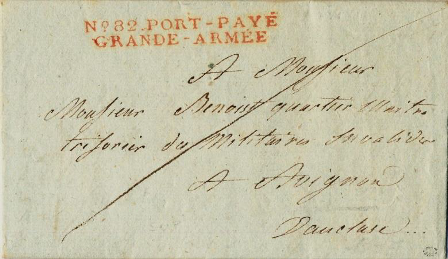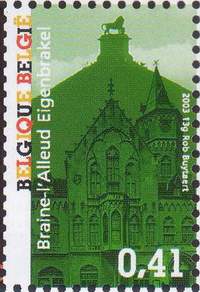Manifestations (préventes, bourses, etc...)
Exposition internationale et bureau temporaire Braphil '15
KIERKEGAARD Asbjörn Royal Philatelic Society London
La Grande Armée 1805-1808 and 1812-1814
The army postal service told by the soldiers’ mail
The 9th of August, 1805, England, Austria, Russia, Naples and Sweden signed a treaty against France. Napoleon replied by rapidly assembling his troops already in garrison in France, in Holland and in Hanover. The military units started a forced march to arrange the meeting with each other in southern Germany. The army “La Grande Armée” was born. Its name was given by Napoleon on the 30th of August, 1805.
The battles of Ulm on the 15th of October and of Austerlitz on the 2nd of December destroyed the Austrian army and peace with Austria was signed In Pressburg (Bratislava). “La Grande Armée” remained in the centre of Germany. Relations with Prussia got more complicated and war with Prussia broke out on the 9th of October, 1806. The army of Prussia was destroyed in the battles of Jena and of Auerstedt on the 14th of October and an armistice with Prussia was signed on the 16th of November. The war against Russia continued in the eastern part of Prussia and in Poland and the battles of Eylau on the 8th of February, 1807 and of Friedland on the 14th of June 1807 led to the Treaty of Tilsit with Russia and Prussia on the 7th of July, 1807.
Napoleon had started the war in Spain and Portugal and needed his military resources there. He therefore dissolved “La Grande Armée” by an imperial decree given in Erfurt on the 12th October, 1808, and moved most of its military resources to Spain.
During 1812 relationships with Russia deteriorated and Napoleon began arming in Central Europe. Step by step he moved his forces from the Rhine River in west towards the Neman River in the east. It was done in secret and the name “La Grande Armée” was not used officially but the characteristic postal markings used by “La Grande Armée” appeared in April 1812. The army crossed the Russian border on the 24th of June and Moscow was reached on the 14th of September. On the 19th of October 1812 “La Grande Armée” began its catastrophic retreat from Moscow.
Napoleon rapidly reconstructed “La Grande Armée” and the war continued in 1813 in Germany. He won the battles of Lützen on the 2nd of May and of Dresden on the 26-27th of August but by losing the battle of Leipzig on the 18-19th of October he lost Germany and in consequence his imperial crown. “La Grande Armée” withdrew to France in late 1813 and fought on French soil until the abdication of Napoleon at Fontainebleau on the 11th of April, 1814.
The armed forces in “La Grande Armée” needed to communicate with France and with each other. Therefore, a military postal service was created and it moved with the army all over Europe and it operated wherever the army had occupied an area.
The aim of the present collection is to display the functions of this army postal service and to illustrate its services to the military forces.
The military postal service used three categories of postal marking on the letters. These marks typically had a standard design with two lines. The postmark used for letters sent postage due had an Arabic number on the first line and the word GRANDE ARMÉE on the second line. The postmark for prepaid letters had an Arabic number followed by the word POST-PAYÉ on the first line and the word GRANDE ARMÉE in the second line and the postmark for letters forwarded to another post office had an Arabic number followed by the word DÉB on the first line and the word GRANDE ARMÉE on the second line. The present collection displays a number of letters with these markings as well as many letters with more atypical markings, used in the army postal service.
The collection encloses letters from both the “first” Grand Army (1805-1808) and the “second” Grand Army (1812-1814) and from most of the territories where the army operated. Some examples of postmarks changed or were repaired during their period of use and such marks are also displayed. When possible it is also indicated whether the letter had been handled by a moving army post office or a sedentary army post office in a fortified town and it is pointed out to which army unit the post office was attached.
The rate to pay for a letter to France depended on the distance between the French border and the receiving civil post office inside France and also on the weight of the letter. The postage to pay was written on the front of a letter sent postage due and on the back of a prepaid letter. The postage paid are analysed for all letters in the collection and the different appearance between prepaid letters and letters sent postage due are clearly illustrated. The postage of a simple letter sent from one point in the Grand Army to another point in the Army was two décimes irrespectively of the travelled distance. The army also had a special low postage rate for prepaid letters to military persons on duty. These special postage rates are also demonstrated by letters in the collection.
Letters could also be send free of postage in the Great Army. The rules for this were complicated and they are explained and displayed by many letters.
The collection also explains and displays how it was possible to send money to soldiers on duty and it also illustrates the system of sending letters by an express postal service on horseback.
 Letter dated in Moscow on the 28th of September, 1812, and sent postage due to Nérac in the Department of Lot and Garonne.
Letter dated in Moscow on the 28th of September, 1812, and sent postage due to Nérac in the Department of Lot and Garonne.
 Prepaid letter dated in Rostock on the 28th of January, 1808, and sent to Avignon in France by the moving army post office attached to the 4th Division in the 4th Army Corps.
Prepaid letter dated in Rostock on the 28th of January, 1808, and sent to Avignon in France by the moving army post office attached to the 4th Division in the 4th Army Corps.

Back of a prepaid letter dated in Livorno in the department of Mediterranean in January 1813, and sent to a soldier in the Great Army. The address was incorrect and the letter was forwarded between three different army post offices in the search of the receiver. Every army post office stamped the back of the letter with its forwarding postmark.

